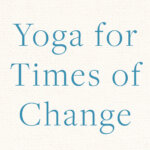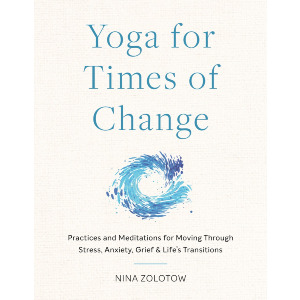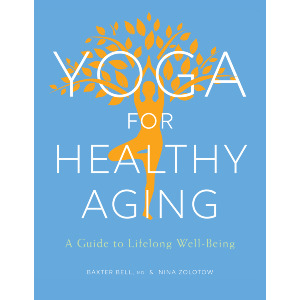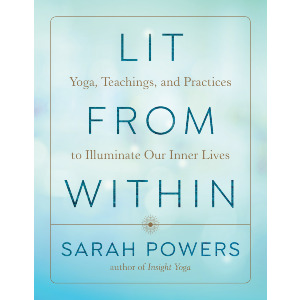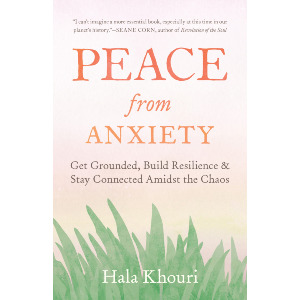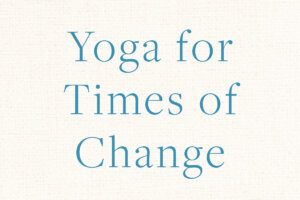
An excerpt from Yoga for Times of Change by Nina Zolotow.
POSITIVE INTERVENTIONS FOR PAINFUL EMOTIONS
In positive psychology, taking steps to regulate your emotions and increase your own well-being is called making “positive interventions.” Sandy Blaine, a positive psychology expert as well as a longtime yoga teacher, says that positive interventions offer us some control over our own emotional states and may help us “ride emotional waves” more skillfully rather than simply reacting. And she says that yoga offers many different options for making positive interventions.
Yoga poses in particular can have a strong effect on your moods and emotions. I myself have been using my asana practice to regulate my emotions for around twenty years now, finding supported inverted poses very helpful for anxiety and backbends very helpful for mild depression. Although there are some general principles regarding the way that specific categories of poses will affect you—for example, that standing poses and backbends are generally stimulating and that inverted poses and forward bends are generally calming—the way a given pose will affect you as an individual may differ from the way it affects someone else. So in this chapter I’ll provide a variety of suggestions for types of poses that could be helpful for anger, anxiety, and depression, and you can experiment to find out what works for you.
Yoga breath practices can also have strong effects on your moods and emotions. Calming breath practices can quiet your mind, slowing down the racing thoughts you can experience due to anger, fear, and anxiety. Balancing practices can be mildly calming or mildly stimulating, bringing you a feeling of stability. Stimulating practices may help energize you physically when you’re feeling lethargic. See chapter 7 for complete information on how these practices work and when to choose which one.
Because we’re all different, however, what works for one person may not work for another. So even though I have some specific suggestions below for the three different basic emotions, finding the best positive interventions for you will always be a matter of experimenting and observing.
Supported poses where you are facing the floor, such as Supported Child’s pose and Prone Savasana, can make you feel safe and comforted. And if anxiety is making you feel fatigued, these and other restorative poses can provide deep rest.
HOW TO PRACTICE FOR EMOTIONAL WELL-BEING
During a period when you’re experiencing anger, anxiety, or depression, it can be especially helpful to regularly practice yoga that specifically addresses what you’re going through. This usually means practicing yoga at home instead of, or in addition to, attending a class or practicing with a video. So if you don’t yet regularly practice yoga at home, consider starting, even if for only very short sessions of fifteen to twenty minutes, perhaps three days a week. And if you do practice at home already, consider practicing six days a week, even if only for very short sessions, during particularly difficult times. It may be challenging to begin a home practice when you’re not already in the habit or to start practicing more often, but taking this important step to help yourself can be very empowering! You’ll soon discover that there are healthy and safe things you can do to move yourself back toward emotional balance whenever you need to.
POSITIVE INTERVENTIONS FOR ANGER AND RESENTMENT
Dr. Lynn Somerstein told me that one winter day when she was walking down the street with her husband, her husband slipped and landed on top of her, breaking her ankle so badly that her foot was dislocated. He was unharmed. On her way to the hospital, she lay on the stretcher feeling like “the lowliest squashed worm.” Later she realized that beneath her depression was strong anger at her husband. She said, “I was enraged and thought I might stay that way, but I didn’t want to lose the relationship. I knew I had to forgive him.” She said what helped her was “Pausing, feeling, accepting. Meditating. Chair yoga at first, then simple yoga on the mat.”
The best positive interventions for anger will vary from person to person, depending on your particular situation, yoga experience, and personal preferences. Charissa Loftis says that she learned to use gentle yoga to “dissipate” the uncomfortable physical sensations her anger caused—the “hot boil” in her torso and face. Making herself more physically comfortable allowed her to feel the anger fully and to then let go of it more quickly than she had in the past. On the other hand, Iyengar Yoga teacher Jarvis Chen says that for some people active, full-body poses that engage all the large muscles of the body “can help the body to meet the energy of the mind and process the excess energy of anger.”
So you’ll need to personalize your own approach by trying different strategies to see which work best for you. But in general, the poses and practices that people who have ongoing anger may find helpful include:
- Standing poses. These poses can be grounding and help you burn off some of the excess energy that anger can cause.
- Inverted poses. These are good for lowering your stress levels, which can tamp down the fight-flight-or-freeze response when you’re too worked up for quieter practices. Inverted poses with head support, such as Supported Standing Forward Bend, Supported Wide-Legged Standing Forward Bend—and even Headstand (Sir-sasana) and Shoulderstand (Salamba Sarvangasana) if you practice them—may be especially cooling for anger.
- Demanding poses. Poses that fully engage your body, such as Downward-Facing Dog pose, Standing Forward Bend, and even Handstand (Adho Mukha Vrksasana) take you into the present moment and can interrupt the cycle of angry thoughts you are caught up in.
- Gentle mini vinyasas. Moving in and out of gentle poses with your breath, as you do in Cat-Cow pose and a Bridge pose vinyasa, engages your mind and body while avoiding the stimulation some more vigorous practices can cause. Charissa told me that for her, moving with her breath was a “nice way to pull my thoughts out of ‘the story’ associated with the anger.”
- Calming breath practices. If and when you’re able to sit still, calming breath practices can reduce your stress levels and quiet your mind. See Breath Practices for Self-Regulation on page 191 for more information.
There are also some poses and practices to consider avoiding when you’re feeling angry. To start, Dr. Somerstein recommends that if you find a particular style of yoga stokes your anger, you should stay away from it. Other practices and poses you might want to avoid include:
- Stimulating breath practices. Some yogic breath practices actually stimulate your nervous system rather than calming you, and these stimulating practices could increase your anger. See chapter 7 for more on these practices.
- Frustrating poses. Poses that cause a lot of frustration or that you just dislike for whatever reason could increase your anger.
- Poses that cause brooding. Poses where you turn inward, such as forward bends, or restorative poses where you feel like you are being left alone with your thoughts can cause some people to ruminate. If you have that experience and the pose increases your anger rather than reducing it, skip it for now.
Not all yogic breath practices are calming, and some forms actually stimulate your nervous system, which could increase your anxiety.
POSITIVE INTERVENTIONS FOR FEAR AND ANXIETY
By chance I had two private students at the same time who were experiencing anxiety and panic attacks. Their life circumstances were very different as were their symptoms, so the programs I designed for them ended up being very different as well.
The first student’s mother had recently died, after she had been at her mother’s bedside in the hospital for weeks, and her panic attacks came when she was in bed in the middle of the night. After experimenting, we decided that the best technique for heading off a full-blown panic attack would be a breath practice where she consciously extended her exhalation. Although even just breath awareness can help with a panic attack or anxiety, having a specific exercise to do helped her focus more on her breath instead of just “watching” it. She later reported back to me, “The breathing has totally helped me, and it even helped me during the day when I was starting to freak out at a restaurant!”
For long-term relaxation, Legs Up the Wall pose was the supported inverted pose that suited her best. Since she was very active already with ballet lessons and wasn’t a regular yoga practitioner, we decided that a mini practice of this one pose for ten to twenty minutes a day would be the best approach for her.
The second student had recently moved away from family and friends to go to graduate school. Her panic attacks came in the daytime, when she was fully awake and getting ready to face her day. She didn’t want to try breath work because the thought of staying still to practice it made her feel even more anxious! Because she was hyper and restless, we decided she should try an active asana practice in the morning to head off the anxiety, followed by a short session of stress management with Supported Bridge pose, her supported inverted pose of choice, to reduce overall stress levels.
Because the best positive interventions for fear and anxiety will vary from person to person, you’ll need to personalize your own approach by trying different strategies to see which works best for you. But in general, the poses and practices that people with anxiety and fear may find helpful include:
- Supported Prone poses. Supported poses where you are facing the floor, such as Supported Child’s pose and Prone Savasana, can make you feel safe and comforted. And if anxiety is making you feel fatigued, these and other restorative poses can provide deep rest.
- Forward bends. Standing and/or seated forward bends can feel safe and quieting when you’re anxious. There are some who find the classic versions of these poses challenging or unpleasant, but there are many ways to make forward bends accessible and even comfortable for most people, some of which are included in Calming Practice for Fear or Anxiety on page 113. So give these variations a try.
- Supported inverted poses. These poses are particularly beneficial for anxiety because the physical orientation of the poses triggers the relaxation response, and concentration isn’t as essential. They may also feel easier for you to practice than quieter forms of relaxation.
- Calming breath practices. If and when you’re able to sit still, calming breath practices can reduce your stress levels and quiet your mind. They may also be useful for heading off a spike in anxiety if you feel an attack coming on because they bring you into the present moment while also quieting your nervous system. See Breath Practices for Self-Regulationon page 191.
- Standing poses. These poses can be grounding and help you burn off some of the excess energy that anxiety can cause.
- Moving with your breath. Practicing gentle vinyasas, where you slowly move in and out of poses with your breath, can take you out of your anxiety and into the present moment and can uplift you emotionally when you’re feeling overwhelmed.
- Stretching your hip joints. In general, releasing physical tension as described under Coping Skill 6: Releasing Physical Tension by Stretching on page 48 can make you feel calmer as well as physically comfortable. Dr. Somerstein says that for anxiety and fear, stretching your hip joints in particular releases “stored bound energy,” which might provide some relief. Hip openers include any standing poses or seated and reclined stretches where you take one leg out to the side, behind you, in front of you, or across the midline of your body.
There are some poses and practices you should consider avoiding when you’re feeling anxious. In general, Dr. Somerstein recommends avoiding power or flow yoga when you’re anxious because, she says, you can get swept up in a fast, difficult routine that might wind you up instead of down, and you might even get hurt. Other suggestions include:
- Stimulating breath practices. Not all yogic breath practices are calming, and some forms actually stimulate your nervous system, which could increase your anxiety. See Breath Practices for Self-Regulation on page 191 for more information.
- Stimulating poses and practices. Some challenging poses, deep backbends, and vinyasas that include jumping or moving quickly between poses can also raise stress levels and increase anxiety.
- Poses that feel unsafe. Poses where you are supine (lying on your back), are tied up with a yoga strap, or have your eyes closed can make you feel vulnerable and increase anxiety. The same is true for poses that scare you, such as full inversions or deep backbends. So, as you practice any of the sequences in this book or any other sequences, whether in a class or on your own, be aware of how poses and practices affect you. If they’re not working for you at this time, find an alternative.
- Meditation. Although meditation is considered to be “calming,” if you’re feeling anxious, sitting alone with your thoughts could cause a downward spiral and make you feel worse. And Dr. Somerstein says that starting a practice on your own, especially when you’re feeling anxious, is actually a bad idea. But if you already have a regular meditation practice and feel that the practice is helpful for your anxiety, then, of course, it’s safe for you to continue practicing.
Share
$27.95 - Paperback
Related Books
$29.95 - Paperback
$19.95 - Paperback
$17.95 - Paperback


